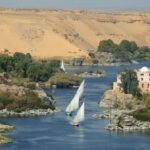In August of 2008 Egyptian authorities announced the discovery of two new suspected tombs in the world famous Valley of Kings, the final resting place of many of ancient Egypt’s royalty as well as most significant historical figures. The two speculated tombs are for now simply referred to as “KV64” and “KV65” in the traditional designations of the Valley of Kings (KV) typology.
Located in the eastern portion of the valley, KV64 and KV65 first appeared as a pair of radar anomalies to the Amarna Royal Tombs Project, that of English Egyptologist Nicholas Reeves, which operated in the Valley of Kings from 1988 until 2002. This would suggest that knowledge of the two or more locations significantly predated the ultimate public announcement. The exact locations of each tomb are as of yet undisclosed to those outside of Egyptian archaeological circles, but various rumors are now readily abundant.
The entrances to the tombs are suggested to be in the the style of the 18th or later Dynasty of ancient Egypt, and excavation duties have now been taken over by the well-known Dr. Zahi Hawass, Secretary General of the Supreme Council of Antiquities, or SCA (not to be confused with the western Society for Creative Anachronism, which instead deals with Medieval European history). Dr. Zahi Hawass has commented that although excavation will eventually and surely take place (originally mentioning that excavation could begin as early as October of 2008) and that preparations are being made, the process must be taken very carefully and cautiously. A rare, well-hidden tomb, unmolested by grave robbers both ancient and modern, may preserve more than just a sarcophagus or mummy; it may preserve sealed air samples and remnants of ancient biology which would be lost forever if the opening of the tomb is spurred with recklessness or haste.
Dr. Hawass additionally suggests the possibility that one of the tombs could house the final resting place and archaeological treasures of a Ramesses Sethherkhepshef Meryamun, better known as Ramesses VIII, (prenomen Usermaatre Akhenamunthe). Ramesses VIII was the 7th Pharaoh of the 20th Dynasty, and the only Twentieth Dynasty Pharaoh with a yet unknown burial location and has been under the tracking eye of a Afifi Rohiem, overseen by Dr. Hawass. With so little known about this ruler and his short-lived reign, such a discovery would graciously impact our currently minimal knowledge of his life.
Speculation also exists that the tomb originally dubbed KV64 and the suspected tomb of Ramesses VIII are completely different planned excavation locations, and that there may be two tombs in addition to that of Ramesses VIII: KV65 to usurp KV64 and thus a hypothetical KV66 to usurp KV65 . The secrecy surrounding the tombs in question and their locations is a necessary measure to make sure qualified excavators get there first, but certainly does nothing to soothe the anxiety of amateur cryptologist’s around the world!
Citations: http://guardians.net/spotlite/spotlite-hawass-2008.htm (Dr. Hawass announces the discoveries)




